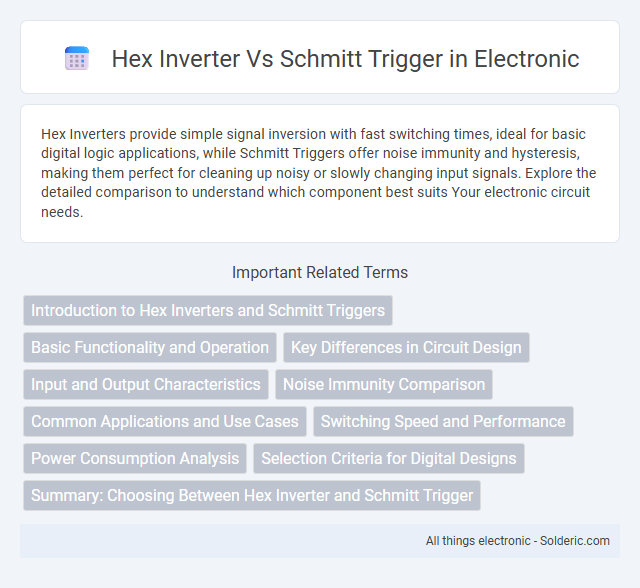Hex Inverters provide simple signal inversion with fast switching times, ideal for basic digital logic applications, while Schmitt Triggers offer noise immunity and hysteresis, making them perfect for cleaning up noisy or slowly changing input signals. Explore the detailed comparison to understand which component best suits Your electronic circuit needs.
Comparison Table
| Aspect | Hex Inverter | Schmitt Trigger |
|---|---|---|
| Definition | Logic gate that inverts input signal. | Comparator with hysteresis for noise immunity. |
| Function | Inverts input logic level (0-1, 1-0). | Converts noisy or analog signal to clean digital output. |
| Input Type | Digital input only. | Analog or noisy digital input. |
| Output Response | Instant inversion. | Stable switching with hysteresis thresholds. |
| Noise Immunity | Low; noise can cause false switching. | High; reduces false triggers via hysteresis. |
| Typical Applications | Basic logic inversion circuits. | Signal conditioning, debounce circuits, waveform shaping. |
| Example IC | 74HC04 | 74HC14 |
Introduction to Hex Inverters and Schmitt Triggers
Hex inverters are integrated circuits containing six independent inverter gates that convert logic highs to lows and vice versa, commonly used in digital electronics for signal inversion and logic operations. Schmitt triggers are specialized comparators with hysteresis, designed to convert noisy or analog input signals into clean digital outputs by providing noise immunity and signal stabilization. Both components play critical roles in electronic circuits, with hex inverters focused on signal inversion and Schmitt triggers enhancing input signal integrity through hysteresis.
Basic Functionality and Operation
A Hex Inverter consists of six independent inverter gates that convert a high input signal to a low output signal, providing simple digital logic inversion. A Schmitt Trigger features a hysteresis characteristic, ensuring stable output transitions by filtering out noise and preventing rapid switching on fluctuating input signals. Your choice between the two depends on whether clean inversion or noise-resistant signal conditioning is required in the application.
Key Differences in Circuit Design
Hex Inverter circuits consist of six independent inverter gates that switch input signals from high to low, whereas Schmitt Trigger circuits incorporate hysteresis by adding positive feedback, resulting in improved noise immunity and signal stability. The key difference in circuit design lies in the Schmitt Trigger's threshold voltage hysteresis, which differentiates between rising and falling input signals to prevent erratic output changes, unlike the straightforward single-threshold switching of the Hex Inverter. Your choice between these components depends on whether your application requires simple inversion or enhanced noise performance and cleaner digital signal transitions.
Input and Output Characteristics
Hex Inverters feature a simple input-output relationship where a high input voltage produces a low output voltage and vice versa, offering straightforward signal inversion with a defined threshold typically near half the supply voltage. Schmitt Triggers incorporate hysteresis with distinct upper and lower threshold voltages for input switching, providing noise immunity by preventing output fluctuations from small input voltage changes. Your choice depends on whether you need basic inversion or stable switching with noise rejection in varying input conditions.
Noise Immunity Comparison
Hex inverters and Schmitt triggers differ significantly in noise immunity, with Schmitt triggers offering superior performance due to their hysteresis characteristic. The built-in hysteresis in Schmitt triggers allows them to maintain stable output states in the presence of noisy or slowly changing input signals, effectively filtering out voltage fluctuations that might cause false triggering in a standard hex inverter. Consequently, Schmitt triggers are more reliable for signal conditioning in environments with electrical noise or signal instability.
Common Applications and Use Cases
Hex inverters are widely used in digital logic circuits for signal inversion, buffering, and generating clock pulses, especially in microcontroller interfacing and basic logic gate implementations. Schmitt triggers are preferred in noisy signal environments for signal conditioning, debouncing switches, and converting analog signals to stable digital pulses, commonly found in sensor input processing and waveform shaping. The choice hinges on noise immunity needs, with Schmitt triggers excelling in cleaning up slow or noisy signals while hex inverters provide straightforward logic inversion.
Switching Speed and Performance
Hex inverters typically offer faster switching speeds due to their simple digital logic design, making them suitable for high-frequency applications. Schmitt triggers incorporate hysteresis, which improves noise immunity and signal stability but can slightly slow down the switching speed compared to standard hex inverters. For performance-critical circuits requiring sharp and clean transitions, hex inverters excel, while Schmitt triggers provide superior reliability in noisy environments with less concern for maximum switching speed.
Power Consumption Analysis
Hex inverters typically exhibit lower power consumption in simple switching applications due to their straightforward design and minimal internal circuitry. Schmitt triggers, with their built-in hysteresis, consume slightly more power as they maintain stable output in noisy environments by preventing rapid switching. For circuits requiring noise immunity and consistent signal integrity, the marginal increase in power usage of Schmitt triggers is balanced against improved performance stability.
Selection Criteria for Digital Designs
When choosing between a Hex Inverter and a Schmitt Trigger for digital designs, focus on signal integrity and noise immunity requirements. Hex Inverters are ideal for fast, clean digital signals without significant noise, while Schmitt Triggers enhance switching reliability by converting noisy or slow input signals into sharp digital outputs. Your selection should prioritize the operating environment and signal characteristics to ensure stable and accurate digital performance.
Summary: Choosing Between Hex Inverter and Schmitt Trigger
Hex Inverters provide clean digital signal inversion ideal for straightforward logic applications, while Schmitt Triggers excel in enhancing signal integrity by converting noisy or analog inputs into stable digital outputs. Schmitt Triggers feature hysteresis, reducing sensitivity to input noise and preventing false triggering, making them suitable for signal conditioning in noisy environments. Selecting between these components depends on the need for noise immunity and signal stability; Schmitt Triggers are preferred for noisy or slow input signals, whereas Hex Inverters suffice for clean, fast digital signals.
Hex Inverter vs Schmitt Trigger Infographic

 solderic.com
solderic.com